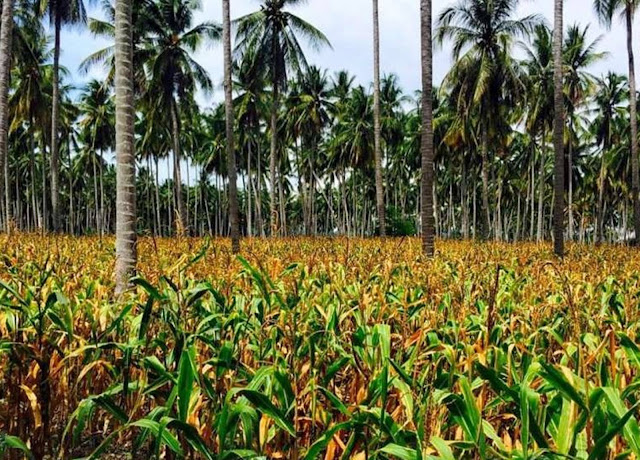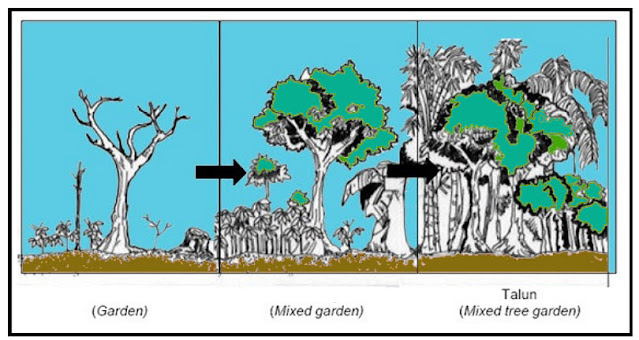Agroforestry, which means simply planting trees on agricultural land. Agroforestry is a forest land management system with the aim of reducing forest destruction or encroachment activities while simultaneously increasing farmers' income.
According to De Foresta and Michon (1997), agroforestry can be classified into two types, namely simple agroforestry systems and complex agroforestry systems.
a. Simple agroforestry
A simple agroforestry system is an agricultural system which is a combination of one type of perennial plant (trees) which are intercropped with one or more seasonal crops. Trees can be planted as hedges around plots of food crops randomly within a plot of land or in other patterns, such as lining up in rows to form a corridor or fence.
The types of trees planted are also very diverse and can plant trees of high economic value such as coconut, rubber, cloves, coffee, cocoa (cacao), jackfruit, belinjo, petai, teak and mahogany or those with low economic value such as dadap, lamtoro and calliandra. The types of seasonal crops usually range from food crops, namely rice (upland), corn, soybeans, secondary crops, beans, cassava, vegetables and grasses or other types of plants such as bananas, coffee, chocolate. For example, cultivation of lamtoro alley cropping with rice or maize, coconut trees planted on embankments around rice fields, etc.
A simple agroforestry system in its development is also a mixture of several types of trees without any annual crops. For example, coffee gardens are usually inserted with dadap (Erythrina) or kelorwono plants, also known as gamal (Gliricidia) as shade plants and soil fertilizers. Another example of intercropping commonly found in the Ngantang area of Malang, Indonesia is growing coffee in pine forests.
Tumpangsari is a simple form of agroforestry which is mostly found in Java Island. This system in the Indonesian version is known as "taungya" which is required in teak forest areas in Java and was developed within the framework of the social forestry program of Perum Perhutani. Farmers are allowed to plant seasonal crops among the young teak trees on the land.
The crop yields are taken by farmers, but farmers are not allowed to cut or destroy the teak trees and all trees remain the property of Perum Perhutani. When the trees have matured, there is no more integration with seasonal crops because of the problem of shade from the trees. This type of tree is planted specifically to produce timber, so that eventually the cropping pattern changes from an intercropping system to monoculture teak plantations. This simple system is often a common feature of commercial agriculture.
Simple forms of agroforestry can be found in traditional agricultural systems in areas with low population densities as well as in densely populated areas. In areas with low population density, a simple form of agroforestry emerged as one of the efforts of farmers to intensify land use due to natural constraints such as swamps.
For example, coconuts are planted intercroppingly with lowland rice in swamps on the coast of Sumatra. Examples of simple forms of agroforestry in densely populated areas include: randu trees planted on rice fields in the Pandaan area (Pasuruan, East Java), coconut or siwalan with tobacco in Sumenep, Madura.
 |
| Figure: Simple agroforestry system |
b. Complex agroforestry systems
A complex agroforestry system is a permanent agricultural system that involves many types of trees (tree-based) either intentionally planted or naturally grown on a plot of land and is managed by farmers following cropping patterns and forest-like ecosystems.
In addition to various types of trees, this agroforestry system also includes shrubs, climbing plants (lianas), seasonal plants and large amounts of grass. The main characteristic of this complex agroforestry system is its physical appearance and the dynamics in it which are similar to natural forest ecosystems, both primary and secondary forests, therefore this agroforestry system can also be referred to as agroforest. There are two types of complex agroforestry systems based on the distance to the place of residence, namely:
- garden agroforestry or tree-based yards (home garden) located near the residence; and
- agroforests which are usually referred to as forests which are located far from the place of residence. For example, agroforestry damar forest in the Krui area, West Lampung or rubber forest in Jambi.
1) Yard or garden
The yard or garden is usually located around the residence and the area is only about 0.1-0.3 ha so that this system is easier to distinguish from forest. For example, namely talun gardens, coral reefs etc. Yards or gardens are the most popular tree-based farming systems in Indonesia for centuries.
A common garden found in West Java is a yard system that begins with logging and burning of forest or shrubs which are then planted with annual crops for several years (garden phase). In the second phase, fruit trees (durian, rambutan, papaya, banana) are intercropped with seasonal crops (mixed garden phase).
In the third phase, several useful forest plants are allowed to grow so that a combination pattern of local native plants is formed, for example bamboo, other wood-producing trees and fruit trees (talun phase).
In this phase, the annual plants that grow under it are very limited because of the large amount of shade. The fusion phase of various tree species is often referred to as the talun phase. Thus the formation of talun has three phases, namely garden, mixed garden and talun.
 |
| Image: Development of the talun garden system. |
2) Agroforests
Agroforests are massive forests that are a mosaic (combination) of several gardens measuring 1-2 ha owned by individuals or groups, located far from their homes and even on village boundaries, and are usually not managed intensively. Examples of rubber agroforestry, damar agroforestry etc. Agroforests are usually formed on former natural forest or shrub land, which begins with logging and burning of all vegetation.
Land clearing is usually done during the dry season. The land is planted with upland rice at the beginning of the rainy season which is inserted with other seasonal crops such as corn and chilies for one to two harvests. After two crops of annual crops, the intensification of land use is increased by planting trees such as rubber, resin or other perennials. This early period, there was a temporary mix of seasonal plants with trees.
When the trees are mature, farmers are still free to combine various other annual plants that are beneficial from an economic and cultural perspective, for example the insertion of durian or duku trees. Annual crops are no longer there.
The original forest plants that are beneficial to farmers are still allowed to grow naturally, and are maintained among the main crops, for example pulai, laban wood, incense and so on. Integration continues throughout the entire life span of the agroforest. Selective felling will be carried out when the main crop starts to be disturbed or if the tree is too old so that it is no longer productive.
